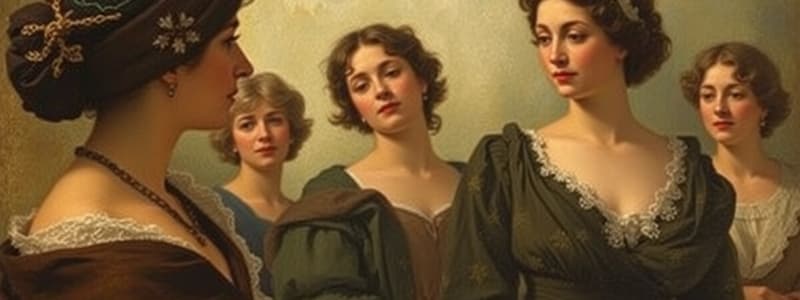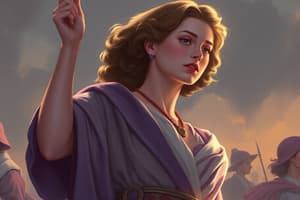Podcast
Questions and Answers
The only signer of the Declaration of Sentiments still living when women gained the right to vote was a man.
The only signer of the Declaration of Sentiments still living when women gained the right to vote was a man.
False (B)
Woodrow Wilson initially supported the women's suffrage amendment without hesitation.
Woodrow Wilson initially supported the women's suffrage amendment without hesitation.
False (B)
Tennessee was the first state to ratify the women's suffrage amendment.
Tennessee was the first state to ratify the women's suffrage amendment.
False (B)
The Voting Rights Act was passed to end voter discrimination in 1965.
The Voting Rights Act was passed to end voter discrimination in 1965.
Japanese Americans received the right to vote in 1920.
Japanese Americans received the right to vote in 1920.
Women fought for their right to vote for decades after suffrage became law.
Women fought for their right to vote for decades after suffrage became law.
Harry T. Burn was in favor of the women's suffrage amendment from the beginning.
Harry T. Burn was in favor of the women's suffrage amendment from the beginning.
The voting age was lowered to 18 in 1971.
The voting age was lowered to 18 in 1971.
Parker Pillsbury was a prominent advocate for women's suffrage and co-edited a newspaper named The Revolution.
Parker Pillsbury was a prominent advocate for women's suffrage and co-edited a newspaper named The Revolution.
Frederick Douglass believed that women should remain dependent on men for their political rights.
Frederick Douglass believed that women should remain dependent on men for their political rights.
Amelia Jenks Bloomer's introduction of the 'bloomer costume' was universally accepted and widely adopted by all suffragists.
Amelia Jenks Bloomer's introduction of the 'bloomer costume' was universally accepted and widely adopted by all suffragists.
Victoria Woodhull was involved in founding the first female-led stock brokerage firm in New York City.
Victoria Woodhull was involved in founding the first female-led stock brokerage firm in New York City.
The Declaration of Sentiments was published in The North Star by Frederick Douglass.
The Declaration of Sentiments was published in The North Star by Frederick Douglass.
Parker Pillsbury suggested that women should rely on men for their own empowerment.
Parker Pillsbury suggested that women should rely on men for their own empowerment.
Amelia Jenks Bloomer founded The Lily, the first newspaper to address women's issues.
Amelia Jenks Bloomer founded The Lily, the first newspaper to address women's issues.
Victoria Woodhull's life choices were widely accepted by society during her time.
Victoria Woodhull's life choices were widely accepted by society during her time.
Josephine St. Pierre Ruffin was the first woman to address women's suffrage before Congress.
Josephine St. Pierre Ruffin was the first woman to address women's suffrage before Congress.
Nina Evans Allender created the 'Jailed for Freedom' suffrage pin.
Nina Evans Allender created the 'Jailed for Freedom' suffrage pin.
Alice Paul drew attention to the suffrage movement through her paintings.
Alice Paul drew attention to the suffrage movement through her paintings.
Inez Milholland Boissevain led a parade of 8,000 women while riding a white horse.
Inez Milholland Boissevain led a parade of 8,000 women while riding a white horse.
Nell Richardson and Alice Snitjer Burke traveled 5,000 miles to promote women's suffrage.
Nell Richardson and Alice Snitjer Burke traveled 5,000 miles to promote women's suffrage.
Harry T. Burn cast the deciding vote for the ratification of the Nineteenth Amendment at the age of 22.
Harry T. Burn cast the deciding vote for the ratification of the Nineteenth Amendment at the age of 22.
Charlotte Woodward Pierce was the only signer of the Declaration of Sentiments still alive when women gained the right to vote.
Charlotte Woodward Pierce was the only signer of the Declaration of Sentiments still alive when women gained the right to vote.
Alice Paul was the founder of the Massachusetts Woman Suffrage Association.
Alice Paul was the founder of the Massachusetts Woman Suffrage Association.
Flashcards
Who was Parker Pillsbury?
Who was Parker Pillsbury?
A man who actively fought for women's rights, believing that men should use their power to empower women.
What did Frederick Douglass say about women's rights?
What did Frederick Douglass say about women's rights?
He was once enslaved and understood the powerlessness of being at the mercy of others. He argued that women lacked essential political power.
What was Parker Pillsbury's role in the women's suffrage movement?
What was Parker Pillsbury's role in the women's suffrage movement?
He was a key figure in the early women's suffrage movement, a co-editor of The Revolution and helped draft the founding document of the American Equal Rights Association.
What was Parker Pillsbury's view on men's role in women's rights?
What was Parker Pillsbury's view on men's role in women's rights?
Signup and view all the flashcards
What was the significance of 'The Lily'?
What was the significance of 'The Lily'?
Signup and view all the flashcards
What was the 'bloomer costume'?
What was the 'bloomer costume'?
Signup and view all the flashcards
Who was Victoria Woodhull?
Who was Victoria Woodhull?
Signup and view all the flashcards
What was Amelia Jenks Bloomer's role in connecting key figures?
What was Amelia Jenks Bloomer's role in connecting key figures?
Signup and view all the flashcards
What is the 19th Amendment?
What is the 19th Amendment?
Signup and view all the flashcards
How long did women fight for suffrage?
How long did women fight for suffrage?
Signup and view all the flashcards
How did the 19th Amendment pass?
How did the 19th Amendment pass?
Signup and view all the flashcards
What happened after the 19th Amendment?
What happened after the 19th Amendment?
Signup and view all the flashcards
What was Woodrow Wilson's stance on the 19th Amendment?
What was Woodrow Wilson's stance on the 19th Amendment?
Signup and view all the flashcards
What is the Voting Rights Act of 1965?
What is the Voting Rights Act of 1965?
Signup and view all the flashcards
Is the fight for voting rights over?
Is the fight for voting rights over?
Signup and view all the flashcards
Who was Josephine St.Pierre Ruffin?
Who was Josephine St.Pierre Ruffin?
Signup and view all the flashcards
How did Nina Evans Allender contribute to the suffrage movement?
How did Nina Evans Allender contribute to the suffrage movement?
Signup and view all the flashcards
Who was Inez Milholland Boissevain?
Who was Inez Milholland Boissevain?
Signup and view all the flashcards
Why was the "Jailed for Freedom" suffrage pin created?
Why was the "Jailed for Freedom" suffrage pin created?
Signup and view all the flashcards
What did Alice Snitjer Burke and Nell Richardson do for the suffrage movement?
What did Alice Snitjer Burke and Nell Richardson do for the suffrage movement?
Signup and view all the flashcards
How did Harry T. Burn contribute to women's suffrage?
How did Harry T. Burn contribute to women's suffrage?
Signup and view all the flashcards
Who was Charlotte Woodward Pierce?
Who was Charlotte Woodward Pierce?
Signup and view all the flashcards
Study Notes
Historic Figures and Activism
-
Countless individuals fought for women's rights, but many are unknown today, appearing only as faces in old photos.
-
Some suffragists gained recognition for a single action or moment.
-
Others contributed greatly, but their efforts have been overlooked due to bias or overshadowed by other achievements.
-
Recognizing lesser-known individuals highlights the importance of their contributions to the women's rights movement.
-
Historical figures' actions offer encouragement to take action based on personal beliefs.
Parker Pillsbury
- Parker Pillsbury advocated for women's right to vote.
- A significant figure in the women's suffrage movement, even ahead of his time
- Believed men should use their political power for women's empowerment, rather than shielding women from politics.
- Played a crucial role in drafting the American Equal Rights Association.
- Lost his job and faced hardship due to his committed work for women's suffrage.
- Selected as a co-editor for a women's rights newspaper, The Revolution.
Frederick Douglass
- Frederick Douglass knew the hardship of slavery, having escaped at age twenty.
- Understood the importance of voting rights for women, emphasizing they were enslaved by their political masters.
- Attended the Seneca Falls Convention as one of the few men present.
- Became a powerful supporter for the women’s right to vote.
- Critically important in memorializing women's suffrage.
Amelia Jenks Bloomer
- Amelia Bloomer popularized a new clothing style (bloomers) among suffragists.
- The style was adopted by many and intended to be more practical attire for women.
- However, this attire did not last in practice, as women returned to traditional clothing.
- Notable for introducing Elizabeth Cady Stanton to Susan B. Anthony, helping to launch a women's suffrage newspaper, The Lily.
Victoria Woodhull
- Victoria Woodhull had a challenging upbringing.
- She and her sister started a crucial female-led stock brokerage in Wall Street.
- She began a career and personal life, which attracted public attention.
- Publicly accused a prominent figure of an affair, generating controversy.
- Declared herself candidate for president, in the face of opposition
Josephine St. Pierre Ruffin
- Josephine St. Pierre Ruffin was influential in women's suffrage, particularly for racially diverse groups.
- Worked to form a club for Black women focused on equal rights
- Was a powerful voice and advocate in her day for equal rights.
Nina Evans Allender
- Nina Evans Allender was a talented artist who used their art to support women's suffrage.
- Created images and cartoons for The Suffragist, a pro-suffrage publication.
- Contributed imagery crucial to the suffrage movement, making the issue more visible and relatable
- Helped depict the image of a suffragist as a confident figure
Alice Paul
- Alice Paul designed a critical "Jailed for Freedom" suffrage pin.
- It was awarded to the women imprisoned for participating in suffrage protests.
- Led an important nationwide speaking campaign concerning women's suffrage.
Inez Millholland Boissevain
-
Inez Millholland Boissevain was an important and prominent figure in the women's suffrage movement.
-
Became the lead figure in the women's suffrage movement in both her activism and appearance
-
Inez played a pivotal role in the fight to achieve women's suffrage, as evidenced by her contributions.
Alice Snitjer Burke
- Were part of an early car advocacy movement, to encourage women's participation in cars and driving.
- They helped to encourage support for woman's suffrage through a cross-country road trip.
- This further highlighted the importance of their campaign to encourage women's participation in cars.
Charlotte Woodward Pierce
- Charlotte Woodward Pierce experienced a hardship-filled life at a young age.
- She was an attendee at the monumental Seneca Falls Convention, alongside other influential figures in the movement.
- Charlotte was instrumental in promoting the women's suffrage movement, particularly through her activism and speeches.
- She was one of the first people to be involved in the women's suffrage movement.
Harry Burn
- Harry Burn held a crucial and pivotal role in the Tennessee state ratification of the women's suffrage amendment.
- His pivotal "yes" vote, influenced by his mother's words, broke the tie and enabled the amendment's adoption.
Suffrage and Universal Enfranchisement
-
Despite the women's suffrage movement's success, other marginalized groups faced continued voter discrimination.
-
African Americans, Asian Americans, and other minority groups still were not ensured suffrage rights.
-
Voting rights issues persisted, as evidenced by historical discriminatory practices that persisted even after the 19th amendment was passed
-
Persistent efforts continued and continue today to ensure more equal voting rights for all US citizens
Studying That Suits You
Use AI to generate personalized quizzes and flashcards to suit your learning preferences.




